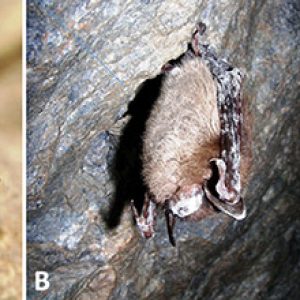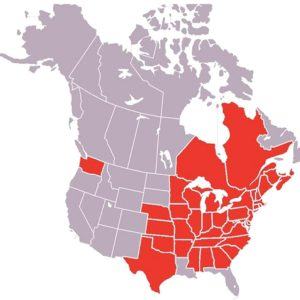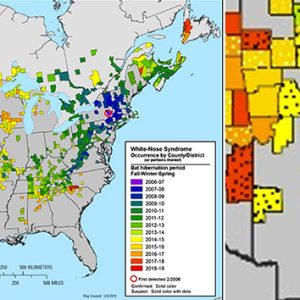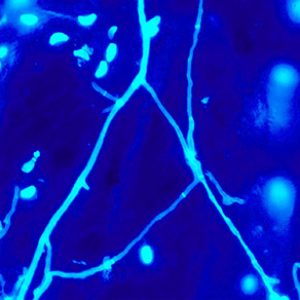calsfoundation@cals.org
White Nose Syndrome
White nose syndrome (WNS) is an emerging disease caused by an exotic fungus of the Phylum Ascomycota, Class Dothideomycetes, and Family Pseudeurotiaceae. This fungus is native to Europe and perhaps portions of Asia and is specifically termed Pseudogymnoascus destructans (Pd). Pd was unknown to science and undescribed until it was identified in 2008. Initially named Geomyces destructans, it was reclassified as P. destructans in 2013. The fungus was first found in Asia and Europe, where scientists believe it had existed for some time, as host bats do not appear to get as ill from the disease it causes. The strain of Pd that made it to North America is thought to have originated from some locality in Europe. There is no cure for WNS. By 2019, the fungus had been found in fifteen Arkansas counties.
The fungus typically grows in the 4 to 15 C temperate range (39 to 59 F) and does not grow at temperatures above 20 C (68 F). Therefore, it is cold-loving extremophile or psychrophile. It has a conidial (asexual, non-motile spore) morphology distinct from other characterized taxa of this genus. An experimental transmission study conducted in 2011 revealed that 100 percent of healthy North American bats infected with the fungus cultured from infected bats exhibit lesions consistent with the disease. Direct microscopy and culture analyses demonstrated that the skin of the WNS-affected bats was colonized by the fungus.
In North America, the fungus was first detected in February 2006 from a photograph of a cave inhabited by infected little brown bats (Myotis lucifugus) near Albany, New York. Pd usually infects bats in their hibernacula during their winter hibernation period—and more than half of the forty-seven bat species occurring in the United States and Canada rely on hibernation for winter survival.
This fungus attacks multiple species of bats, especially those that utilize caves and abandoned mines. By 2017, it had been responsible for the deaths of about 5.7 million North American bats and had spread from an initial invasion site in New York south to southern Mississippi, west to eastern Oklahoma and Nebraska, and north into southern Ontario and southern Quebec, Canada. WNS has now been detected as far south as central Mississippi and as far west as the coast of Washington. It has been observed in thirty-three states and seven Canadian provinces. The fungus knows no borders, and it is expected to spread.
Twelve species of North American bats have been confirmed with WNS, and the causative fungus has been found on an additional six species, including two endangered taxa, the gray bat (Myotis grisescens) and Indiana bat (Myotis sodalis), and one threatened species, the northern long-eared bat (Myotis septentrionalis). At some sites, 90 to 100 percent of bats have died at several hibernacula in Connecticut, Massachusetts, New York, and Vermont. Noteworthy among those that have been hardest hit by WNS are M. lucifugus, M. septentrionalis, and tricolored bats (Perimyotis subflavus). Other species, like the Virginia big-eared bat (Corynorhinus townsendii virginianus), have been found with Pd, but no diagnostic symptom of WNS has been documented, and they apparently do not exhibit signs of sickness with the disease. Fourteen species of bats in Europe have been confirmed with WNS, while another six have had Pd detected, without any diagnostic sign of the disease.
The fungus thrives most in cold, moist sites where bats hibernate and grows on them while they are in an inactive state of hibernation. An infected bat often presents with white fuzz on its muzzle, ears, and other hairless parts of the body, including its wings; infected bats also appear emaciated. If biologists cannot see this growth on bats that have Pd., they can detect it on live bats by wiping the bat with a sterile swab for molecular or culture analysis or by taking a small tissue biopsy for microscopic analysis. The fungus is capable of damaging their skin so much so that bats will warm up and become active, wasting vital fat reserves and stored energy that they must have to persist through the dormancy of winter. In addition, infected bats may take part in unusual behaviors like flying outside in the daytime in the winter.
WNS is spread from an infected bat to other bats by direct contact, and colonial bats in particular have a great deal of direct contact with each other. Interestingly, however, not every bat that comes into contact (either bat-to-bat or otherwise) with Pd becomes sick. Several species, in fact, have been found with Pd but have not been affected. Pd can also be spread in colonies or from surfaces that have Pd on them. Scientists can confirm WNS by examination of the skin under light microscopy, as bats with WNS often have small pockets in their skin caused by Pd infection. The disease appears to be order specific to chiropterans, as no other animals or humans have been known to get WNS.
A National Decontamination Protocol has been updated to reflect the current known distribution of Pd in the United States and recent laboratory testing results of previously approved decontamination agents. Because spores of Pd can persist on surfaces for a long time and can be on clothes, shoes, outdoor gear, and equipment, a person who is at a site where WNS occurs can also inadvertently spread Pd if they go to a new locale where the fungus does not occur. Therefore, specific guidelines have been provided by state and federal officials for cleaning and disinfecting clothes and gear for those who often visit caves and other places where bats hibernate. One recommendation is for treatment of submersible gear in hot water at 60 C (140 F) for 20 minutes. There are different management areas in the United States, and the evolving statuses of several states, as of 2019, are shown here: (1) At Risk to Intermediate (Colorado, Montana, New Mexico, Wyoming,); (2) Intermediate to Endemic (Arkansas, Michigan, Wisconsin); and (3) Endemic to Intermediate (North Carolina). Also, the National Speleological Society (NSS) maintains up-to-date information on its website to keep cavers apprised of current events and advisories on WNS.
One strategy for containment advocated by the U.S. Fish and Wildlife Service has been to blame cavers for spreading the fungus and encourage the closure of public-owned caves to the public, with show caves being excluded from the closure. The containment strategy may seem valid to people lacking a scientific background. However, when a map showing the spread of WNS is examined, it clearly shows that the margins of the area where infected bats have been found radiate farther outward each year from the initial infection site. That strongly suggests that bats are spreading the disease rather than cavers being the dispersal agent. If cavers or others were transporting the spores and subsequently infecting bats, the distributional pattern would be dramatically different.
In Arkansas in 2012, the Arkansas Game and Fish Commission (AGFC) confirmed the presence of WNS in two M. septentrionalis found at a cave on natural area land in Marion County managed by the Arkansas Natural Heritage Commission. Five dead bats were found during the survey. Bats had damage to wing, ear, and tail membranes consistent with WNS. Researchers returned to the cave a week after their initial survey and found 116 endangered Ozark big-eared bats (Corynorhinus townsendii ingens), fifteen northern long-eared bats, and thirty tricolored bats in the cave. No visible signs of WNS were seen on these bats, although WNS is not known to impact Ozark big-eared bats. In addition, a low level of Pd was detected in two caves in northern Arkansas, including Devil’s Den State Park in Washington County and a private cave located in southern Baxter County. As of 2019, WNS or the fungus associated with it has been found in fifteen Arkansas counties. Several locations in the Ouachita Mountains and additional sites in the Ozark Mountains have been found to harbor bats with WNS. For example, it has been confirmed in bats in caves in Franklin and Searcy counties, and Pd has been found in abandoned mines in Garland and Polk counties. Surveys conducted by researchers across the state found that populations of several species of Arkansas bats are beginning to decrease due to the impact of WNS. Indeed, populations of one very common bat (P. subflavus), once found in most Arkansas caves and abandoned mines, declined by about 66 percent from 2015 to 2017, and a statewide estimate of the species went from around 1,800 in 2009 to only 80 bats during the survey in winter 2016.
The AGFC has encouraged private landowners to prohibit public access to their caves to help slow the spread of WNS by humans and to protect bats. Cave explorers should check with land owners and property managers before visiting any cave. All cave visitors should decontaminate clothing, footwear, and equipment before and after cave visits, following national WNS decontamination protocols. The primary purpose of the strict protocols is to minimize the potential for transmission of WNS while handling bats (both between handler and bats and between bats).
A WNS Response Team has been organized, composed of a group of biologists, land managers, and researchers across North America united in the fight against the disease. They originate from more than 100 federal, state, and provincial agencies, tribes, universities, and non-governmental groups. They are collaborating to study the disease, understand how it spreads and infects bats, and discern what can be done to control it. Their primary goal is to prevent permanent loss of bat populations due to WNS. With a goal of increasing survival rates for bats with this overwhelming disease, several experimental treatments are in progress.
For additional information:
Ammerman, Loren K., Christine L. Hice, and David J. Schmidly. Bats of Texas. College Station: Texas A&M University Press, 2012.
Arkansas Game and Fish Commission. Fungus That Kills Bats Prompts Continued Precautions at Arkansas Caves. Little Rock: Arkansas Game and Fish Commission, 2013.
Blehert, David S. “Experimental Infection of Bats with Geomyces destructans Causes White-Nose Syndrome.” Nature 480 (2011): 376–378.
Blehert, David S., A. C. Hicks, M. Behr, C. U. Meteyer, B. M. Berlowski-Zier, E. L. Buckles, J. T. Coleman, S. R. Darling, A. Gargas, R. Niver, J. C. Okoniewski, R. J. Rudd, and W. B. Stone. “Bat White-Nose Syndrome: An Emerging Fungal pathogen?” Science 323 (2009): 227.
Drees, K. P., Jeffrey M. Lorch, S. J. Puechmaille, K. L. Parise, G. Wibbelt, Joseph R. Hoyt, K. Sun, A. Jargalsaikhan, M. Dalannast, J. M. Palmer, D. L. Lindner, A. Marm Kilpatrick, T. Pearson, P. S. Keim, D. S. Blehert, and J. T. Foster. “Phylogenetics of a Fungal Invasion: Origins and Widespread Dispersal of White-Nose Syndrome.” mBio 8 (2017): e01941–17.
Frick, W. F., J. F. Pollock, A. C. Hicks, K. E. Langwig, D. S. Reynolds, G. G. Turner, C. M. Butchkoski, and Thomas H. Kunz. “An Emerging Disease Causes Regional Population Collapse of a Common North American Bat Species.” Science 329 (2010): 679–682.
Fritze, M., and S. J. Puechmaille. “Identifying Unusual Mortality Events in Bats: A Baseline For Bat Hibernation Monitoring and White-Nose Syndrome Research.” Mammal Review 48 (2018): 224–228.
Gargas, A., M. T. Trest, M. Christensen, T. J. Volk, and David S. Blehert. “Geomyces destructans Sp. Nov. Associated with Bat White-Nose Syndrome.” Mycotaxon 108 (2009): 147–154.
Harvey, Michael J., J. Scott Altenbach, and Troy L. Best. Bats of the United States and Canada. Baltimore, MD: Johns Hopkins University Press, 2011.
Langwig, K. E., W. F. Frick, J. T. Bried, A. C. Hicks, Thomas H. Kunz, and A. M. Kilpatrick. “Sociality, Density-Dependence and Microclimates Determine the Persistence of Populations Suffering from a Novel Fungal Disease, White-Nose Syndrome.” Ecology Letters 15 (2012): 1050–1057.
Leopardi, S., D. Blake, and S. J. Puechmaille. “White-Nose Syndrome Fungus Introduced From Europe to North America.” Current Biology 25 (2015): R217–R219.
Lindner, D. L., A. Gargas, J. M. Lorch, M. T. Banik, J. Glaeser, Thomas H. Kunz, and D. S. Blehert. “DNA-Based Detection of the Fungal Pathogen Geomyces destructans in Soils from Bat Hibernacula.” Mycologia 103 (2011): 241–246.
Perry, Roger W., and Phillip N. Jordan. “Changes in the Forest Bat Community After Arrival of White-Nose Syndrome in the Ouachita Mountains of Arkansas.” Southeastern Naturalist 21.2 (2022): 107–115.
Sealander, John A., and Gary L. Heidt. Arkansas Mammals: Their Natural History, Classification, and Distribution. Fayetteville: University of Arkansas Press, 1990.
Turner, G. G., D. M. Reeder, and T. H. Coleman. “A Five-Year Assessment of Mortality and Geographic Spread of White-Nose Syndrome in North American Bats and a Look to the Future.” Bat Research News 52 (2011): 13–27.
U.S. Fish and Wildlife Service (USFWS). North American Bat Death Toll Exceeds 5.5 Million from White-Nose Syndrome. News Release. Arlington, VA: U.S. Fish and Wildlife Service, 2012.
Verant, M. L., C. U. Meteyer, J. R. Speakman, Paul M. Cryan, Jeffrey M. Lorch, and David S. Blehert. “White-Nose Syndrome Initiates a Cascade of Physiologic Disturbances in the Hibernating Bat Host.” BMC Physiology 14 (2014): 10.
Warnecke, Lisa, James M. Turner, Trent K. Bollinger, Jeffrey M. Lorch, Vikram Misra, Paul M. Cryan, Gudrun Wibbelt, David S. Blehert, and Craig C. R. Willis. “Inoculation of Bats with European Geomyces destructans Supports the Novel Pathogen Hypothesis for the Origin of White-Nose Syndrome.” Proceedings of the National Academy of Sciences of the United States of America 109 (2012): 6999–7003.
White Nose Syndrome. Invasive Species Program, U.S. Geological Survey. https://www.usgs.gov/ecosystems/invasive-species-program/science/white-nose-syndrome (accessed January 15, 2020).
White Nose Syndrome Response Team. U.S. Fish and Wildlife Service. https://www.whitenosesyndrome.org/ (accessed January 15, 2020).
WNS Science Strategy Group. Questions, Observations, Hypotheses, Predictions, and Research Needs for Addressing Effects of White-Nose Syndrome (WNS) in Hibernating Bats. Online at http://batcon.org/pdfs/WNSMtgRptFinal2.pdf (accessed January 15, 2020).
Zukal, J., H. Bandouchova, J. Brichta, A. Cmokova, K. S. Jaron, M. Kolarik, V. Kovacova, A. Kubátová, A. Nováková, O. Orlov, J. Pikula, P. Presetnik, J. Šuba, A. Zahradníková, and N. Martínková. “White-Nose Syndrome without Borders: Pseudogymnoascus destructans Infection Tolerated in Europe and Palearctic Asia but Not in North America.” Scientific Reports 6 (2016): 19829.
Chris T. McAllister
Eastern Oklahoma State College
 Science and Technology
Science and Technology White Nose Syndrome
White Nose Syndrome  WNS Affected Areas
WNS Affected Areas  WNS Occurrence
WNS Occurrence  WNS Pathology
WNS Pathology 




Comments
No comments on this entry yet.